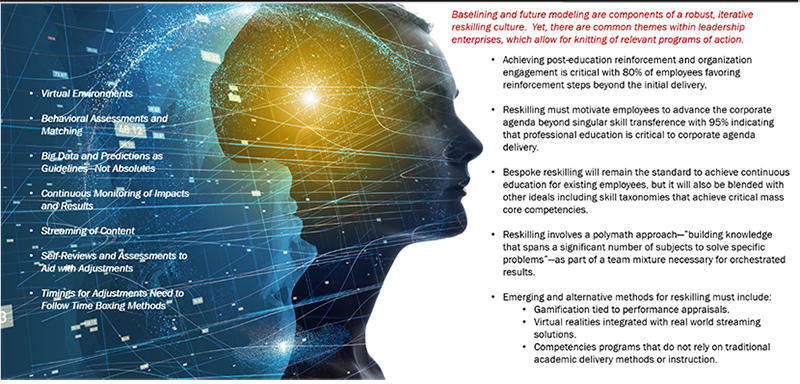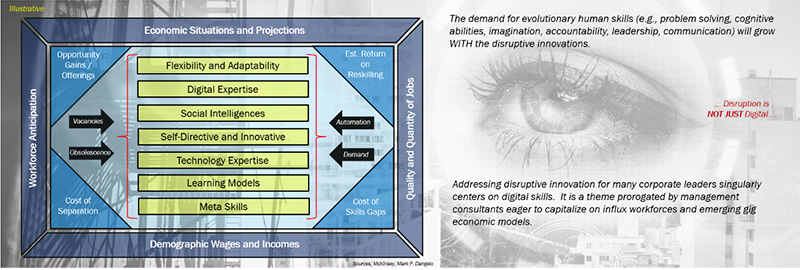
Mark P. Dangelo: The Challenges of Reskilling—Part 3

(Mark P. Dangelo is president of MPD Organizations LLC, featuring books, industry reports and articles. He is a strategic management consultant, outsourcing advisor and analytics specialist with extensive process, technology and financial results and is a frequent contributor to MBA NewsLink. He can be reached at mark@mpdangelo.com or at 440/725-9402.)
(This is part 3 of a series. Part 1 can be accessed at https://newslink.mba.org/mba-newslinks/2020/january/mark-p-dangelo-the-challenges-of-reskilling-workforces-part-1/. Part 2 can be accessed at https://newslink.mba.org/mba-newslinks/2020/february/mark-p-dangelo-the-challenges-of-reskilling-workforces-part-2/ .)
As noted, when I opened the start of this series on reskilling workers, we must recognize and mitigate the environment in which workers find themselves as they seek new skills and competencies. Let me mention just a few of the challenges not mentioned in the prior articles.
Collectively, societies are now divided by their variations rather than their commonalities—division is now the new currency of media, governments and even workforces. Moreover, as industry executives seek to remain Swiss-neural so as not to offend customers, their (in)actions are painted in their responses to rhetoric and regulatory compliance by political operatives—as we all can document over the last decade by financial services and banking organizational leaders.
Individually, and in general (> 70%), we promote sweeping system advocacy change if it doesn’t impact us. Corporations have for decades traditionally put the burden of reskilling on the individual—not the entity for which they work. Obviously, these limiting challenges do not improve the dilemma created with the arrival of the Fourth Industrial Revolution (#4IR)—a “burning platform” of corporate and social mandates for reskilling of workforces as compared to traditionally siloed organizational upskilling approaches.

As 4IR begins its journey, we are witnessing “revolutions” around its implementation as organizations such as the World Economic Forum announce partnerships with Middle Eastern countries (e.g., Saudi Arabia) to create hubs of global innovation delivered at a regional level. Why? What is so different?
To ensure workforces within politically sensitive countries are not left behind, while promoting wealth distribution in the form of training, competencies and lasting economic value. However notable, it still leaves many western enterprises grappling with protectionism mandates, which increase domestic liabilities (i.e., burdens) and costs of operation to integrate emerging skills and competencies.
So, in part 3, we will look at four of the most common options presenting themselves to enterprises seeking to continuously reskill their workforces. And, as we will see in the following section, the starting foundation reskilling begins with alignment of strategy—as it is much more than an operational #R set of activities.
A Framework for Consideration
Whereas the focus for many HR departments pushed by their respective hiring managers, resides with new, hard to find digital skills, this myopic approach to filling capability gaps will result in a patchwork landscape of siloed personnel unable to breakout from the boundaries placed on them. Without understanding of and integration with economic and environmental factors, enterprise’s will be at the mercy of internal politics and expert opinions that may have little efficacy for organizational sustainability and growth.
Moreover, as innovations accelerate and become layered leading to blending of delivery principles and ideals, the belief in singular skill focuses (i.e., digital, digitization, digitalization) will yield diminished ROI’s for enterprises seeking to gain competitive advantages. As partners and vendors become greater segments of corporate cloud and compartmentalized solutions, it will be the orchestration of skills which lead future operational models. Leaders, like an orchestra’s conductor, will need to “direct” varied “chairs” across teams and enterprises.
The following illustrative diagram presents a framework where events and considerations layer upon each other and factor into potential options.

And, one thing that often is misunderstood in the world of FSBOs attempting to instill reskilling cultures within their enterprises, innovation disruption leading the very early stages of 4IR is not just digital. Meaning, to believe that investments and skills focused around digitization is an end-state is misguided—4IR is just beginning and these digital investments just provide the means to compete.
Four Distinct Options
Enterprises that recognize the need for reskilling will be ahead of the curve—if they act to mitigate the challenges and allow for flexible roadmaps to be undertaken. In the spirit of framework above, we will quickly review four developing options for leadership seeking out effective reskilling approaches.
| Option A: Build from The Baseline and Existing Practices The temptation for institutions, especially progressive and of significant size, is to assume that their staff, their culture, their practices will be adaptable to innovation progression. “A tweak here, an inclusion there” and the professional reskilling initiative should be enough to meet demands—customer and profitability—in the timeframes needed and with the competencies required. Yet, are these compositions able to withstand iterations? Are they agile and able to be constantly measured? Do the metrics represent the truth or are they a self-fit cocoon? When critiquing the traditional educational approaches already employed by the enterprise, are these programs and disciplines serving the need of the corporate goals? Do they adhere to retention standards and values for the enterprise? Competency-based reskilling approaches are the trend across for-profit reskilling vendors. Yet, are the skills dispersed too generic or too granular to be of value? Is the delivery about academic purity in the disguise of discipline enlightenment or is it focused on industry practicality that is too arcane for the enterprise’s baseline? Will the new teaching approaches to deliver reskilling demands result in greater retention and reinforcement? By using innovations such as VR tied to content (i.e., streaming and static), is the delivery a novelty or a leading-edge trend? Gamification learning, especially when delivered via MMO (and MMORPG), allows for reinforcement, but how can it be taken seriously? |
| Option B: Partnerships Based on Supply Chain Solutions Partnering with enterprises that offer supply chain solutions may range from logistic components, to packing, to 3D printing, to technology cloud offerings, to variable provisioning to fintech processes. Each of these “vendors” offers a range of capabilities that require an orchestration approach to ensure best-fit and efficient results. Supply chains exist in both product and service enterprises, and with reskilling, all industries are being forced to deal with innovative designs that are disrupting traditional delivery methods. Therefore, enterprises may seek to be an industry orchestrator who concentrates on the layers of assembly rather than the underlying personnel that support the discrete and highly specialized areas that are not economical for standalone efficiencies. Use of partnerships to augment or replace reskilling demands is tempting, but it puts the enterprise in a precarious relationship. Will the partner perform to standards set forth and what are the remedies?Partners within a supply chain, given the innovation landscape, may be temporary and iterative. The result will be a continual migration of data and delivery processes that while meeting customer demands, will also create unprecedented orchestration techniques not common within traditional enterprises. For example, how will continual, iterative migrations from supplier (with their technology bundles) be accomplished? Partners will require training on the bespoke market offerings customers have come to expect from the enterprise. The time for this transference must be not only anticipated but also constantly allocated to accommodate for continuous change. How will the partners then reskill enterprise workers on how to use their supply chain solutions? Partnering for supply chain solutions also requires them to reskill their personnel AND the solution offering at the demands of the enterprise. If partners lag enterprise requirements, who will suffer? What will be the ramifications? |
| Option C: Stacked “Uber” Outsourcing Partnerships For enterprises seeking to reskill, the lure of reducing FTE levels may outweigh the traditional approaches. The result would be greater dependence on new-age outsourcing solutions that focus on Next-Gen skills without placing the burden of reskilling on existing leadership and training personnel. As nationalistic priorities take precedence over globalization, extensive use of “uber” outsourcing may be norm until 2024. Enterprises that provide “uber” outsourcing will leverage the traditional BPO and KPO practices but use their delivery capabilities to provide advanced skills—not just a function of arbitrage or process reengineering. Moreover, uber outsourcers can spread highly sought-after individuals across numerous clients economically, allowing for future reskilling to be undertaken at price-points that are competitive. Enterprises that look to avoid the investment and pitfalls of reskilling will increasingly turn to uber outsourcing to not only secure the skills, but to ensure that highly competent and industry specific teams are at the ready to assist with variable workloads. Uber outsourcing models will start out resembling staffing approaches but will migrate quickly into “black boxes” where inputs are fed to teams that have access to advanced technologies and toolsets to process oceans of customer and process data.Certifications of uber outsourcing offerings will borrow principles from traditional SSAE 16 methods to ensure conformance to (auditing) standards, but also to limit disclosure of proprietary intellectual solutions contained within compartmentalized offerings (i.e., the black boxes). Outsourcers can spread not only the (re) skilling cost across clients, but also the risk and the mitigation methods that must be adopted. For high-cost and value data analysts and scientists, the evolution of their disciplines offers immediate competitive and customer services without the long lead times to achieve competencies and efficiency. Uber outsources reside domestically, internationally or blended thereby benefiting multiple economies. |
| Option D: Adapt a Multi-pronged Approach to Allow Greater Flexibility The pace of innovation will likely, as some have labeled, usher in a “Peak Decade” (from #Davos2020). As global trade declines further, weaknesses within economies will be heightened by skills deficiencies and inefficiencies brought on by barriers. Investments in innovations, along with technological advancements, will concentrate within or near the growing megacities around the globe. As skill assets congregate, countries without robust reskilling programs will economically deteriorate forcing a purge of workers in favor of those who can afford to adapt. The unrecognized complexity of reskilling will be one of the greatest failures for enterprises structuring to comprehend and capitalize on changing markets. These failures will likely contribute to a loss of 20% to 35% of businesses in the coming decade. Enterprises accustomed to singular solutions when it comes to professional development and new hires will be struggling to adapt to innovation skills needed for this “Peak Decade.” A blending of approaches delivered by emerging processes and skills, can only be accomplished using orchestration coupled with adaptative strategic goals and objectives underpinned by continuous measurements. The cost of education (i.e., reskilling) for the next decade if new approaches are not integrated into the professional development mix is likely to exceed $600 billion in the United States alone. A blended approach to reskilling therefore offers a best-fit set of options but only if the enterprise culture and the mapping of baselines to projected needs is done and iteratively updated to reflect the hyper acceleration of market conditions due to the ramifications of innovation singularity. Use of gamifications, VR-delivered content, streaming media and often neglected reinforcements, must become commonplace or enterprise costs for reskilling will skyrocket as traditional approaches and academics miss the mark. |
Indeed, the complexity of reskilling workforces is multifaceted —some might say downright daunting. The challenges are downplayed in favor of the focus on disruptive innovations such as the upcoming 5G spectrums and the impacts this will have on agriculture (e.g., planting), autonomous robots (e.g., automobiles), and information exchanges (e.g., data oceans). All important, but a bit distracting.
In reaching the end of this series, we have examined not only what is missing within enterprise efforts to hire the “best, most qualified” people, but also the huge chasms of efforts missing to reskill existing workforces. Missing within most professional development programs are objective and comprehensive baselines for each employee and the mapping to future needs—and reviewed and addressed more than yearly or quarterly. Also, don’t forget the reinforcement and feedback needed for continuous adjustment.
The need for reskilling of workforces is materially absent from enterprise strategy, as are the extensive challenges facing existing employees on mastering hyper accelerated innovation—often referred to in industry press as Industry 4.0 and also noted in The Ramifications of Innovation Singularity, released in 2019. Innovation has become so invasive and common that consumers and providers often miss how it has changed human behaviors and social constructs. These rapid economic, demographic and business changes have exceeded the abilities of educational institutions to adapt.
The void of skills, as evidenced by the huge gap in demand versus availability, shows the fallacies of traditional approaches coupled with the 8-fold rise of educational costs versus usage potential. The idea that it is the individuals’ responsibility to “stay current” is now a proven fallacy that enterprises can no longer ignore.
Because of the failed reskilling strategies and actions, enterprises will increasingly be turning to new forms of outsourcing, competency learning and layered or stacked solutions, which rely heavily on orchestration of personnel and capabilities. Across the three parts, we have taken a deep dive into the rationale and implications of a hyper accelerated innovation capabilities demanded at the dawn of industry 4.0 reskilling solutions, and reskilling is a cornerstone requirement for every enterprise—especially FSBOs.
We have arrived at the conclusion—reskilling of workforces will be THE largest challenge for FSBO leaders in the coming decade. It will determine who survives and who becomes a footnote in history. How’s that for being a bit sensationalist?
(Views expressed in this article do not necessarily reflect policy of the Mortgage Bankers Association, nor do they connote an MBA endorsement of a specific company, product or service. MBA NewsLink welcomes your submissions. Inquiries can be sent to Mike Sorohan, editor, at msorohan@mba.org; or Michael Tucker, editorial manager, at mtucker@mba.org.)
